
The Internet and You: A Comprehensive Guide to Digital Safety
Navigating the vast ocean of the Internet can feel like an expedition into the unknown, brimming with excitement, but fraught with potential danger. The online world, much like the physical one, is a mixed bag of opportunities and threats. As technology intertwines more closely with our daily lives, understanding how to protect oneself in this digital landscape becomes critical.
In this era of ubiquitous connectivity, Internet safety goes beyond protecting your computer from malware. It involves safeguarding your personal information, reputation, and even mental well-being. This article aims to serve as a comprehensive guide to help you sail through the Internet safely.
Understanding the Risks
When we talk about risks on the Internet, the most apparent ones that come to mind are viruses and malware. However, threats are far more diverse. Phishing scams lure you into giving away your personal information, while cyberbullying impacts mental health. Internet safety is all about identifying these risks and implementing strategies to counter them.
Just as you wouldn’t leave your house door open while you’re away, you should not leave your digital doors unsecured. Awareness of potential threats is the first step towards ensuring a safer digital experience.
Protecting Your Personal Information
One of the most valuable commodities in the digital era is personal information. Cybercriminals are constantly developing new ways to steal this data for various malicious purposes, including identity theft. Protecting your personal information is crucial. This includes everything from your date of birth and home address to your bank account details.
Ensure that your social media accounts are set to private and be cautious about the information you share online. A general rule of thumb is to only post information that you’d be comfortable sharing with a stranger. Regularly updating your passwords and using two-factor authentication are also highly recommended for additional security.

Implementing Safe Online Practices
In addition to protecting your personal information, it’s essential to implement safe practices while interacting with others online. This can range from double-checking before you click a link or download an attachment to being cautious of who you interact with online.
Remember, not everyone on the Internet has good intentions. Be wary of unsolicited contact, particularly if they are asking for personal information or money. When it comes to kids, parental controls and monitoring their online interactions can provide an extra layer of security.
Staying Safe in an Ever-Evolving Digital Landscape
As we continue to embrace the digital age, the need for Internet safety only increases. The risks may be ever-evolving, but by keeping abreast of new threats and implementing safe online practices, you can reduce your chances of falling victim to cybercrime.
Internet safety is everyone’s responsibility – from tech companies and governments to individual users. By understanding the risks and taking proactive steps to protect ourselves, we can ensure that the Internet remains a resourceful tool rather than a dangerous minefield. As the adage goes, forewarned is forearmed. Stay safe in the digital world, and make your online experience a positive one.



